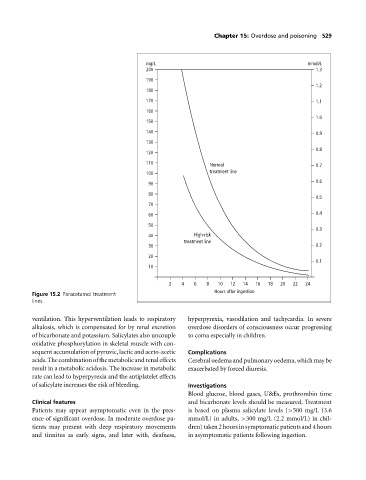Page 533 - Medicine and Surgery
P. 533
P1: KOA
BLUK007-15 BLUK007-Kendall May 12, 2005 20:54 Char Count= 0
Chapter 15: Overdose and poisoning 529
mg/L mmol/L
200 1.3
190
1.2
180
170 1.1
160
1.0
150
140 0.9
130
0.8
120
110 Normal 0.7
100 treatment line
0.6
90
80
0.5
70
60 0.4
50
0.3
40 High-risk
treatment line
30 0.2
20
0.1
10
2 4 6 8 10 12 14 16 18 20 22 24
Hours after ingestion
Figure 15.2 Paracetamol treatment
lines.
ventilation. This hyperventilation leads to respiratory hyperpyrexia, vasodilation and tachycardia. In severe
alkalosis, which is compensated for by renal excretion overdose disorders of consciousness occur progressing
of bicarbonate and potassium. Salicylates also uncouple to coma especially in children.
oxidative phosphorylation in skeletal muscle with con-
sequent accumulation of pyruvic, lactic and aceto-acetic Complications
acids.Thecombinationofthemetabolicandrenaleffects Cerebral oedema and pulmonary oedema, which may be
result in a metabolic acidosis. The increase in metabolic exacerbated by forced diuresis.
rate can lead to hyperpyrexia and the antiplatelet effects
of salicylate increases the risk of bleeding. Investigations
Blood glucose, blood gases, U&Es, prothrombin time
Clinical features and bicarbonate levels should be measured. Treatment
Patients may appear asymptomatic even in the pres- is based on plasma salicylate levels (>500 mg/L (3.6
ence of significant overdose. In moderate overdose pa- mmol/L) in adults, >300 mg/L (2.2 mmol/L) in chil-
tients may present with deep respiratory movements dren) taken 2 hours in symptomatic patients and 4 hours
and tinnitus as early signs, and later with, deafness, in asymptomatic patients following ingestion.

